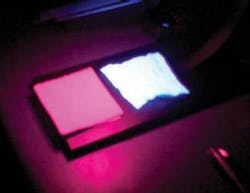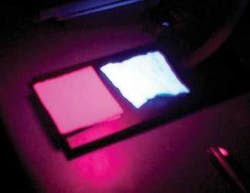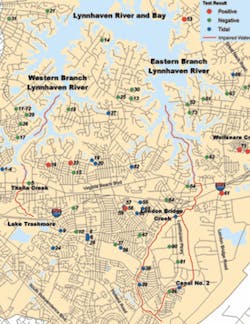Monitoring Optical Brighteners Helps Track Watershed Pollution
The Lynnhaven River and its tributaries in Virginia Beach, VA, are currently in violation of the state’s water quality standards for fecal coliform bacteria and dissolved oxygen in shellfish waters. As a result, many segments of the river are listed as impaired on Virginia’s 303(d) Total Maximum Daily Load Priority List.
To better understand the problem, in 2004 the City of Virginia Beach investigated potential sources of sanitary wastewater that may be entering the Lynnhaven River via the storm drainage system. The city’s consultant used an innovative technique to detect human waste signatures: monitoring for a particular class of dyes added to many laundry detergents.
Optical Brightener Monitoring
Optical brightener monitoring (OBM) is a promising new technique to screen for a surrogate of human bacterial contamination in storm drainage outfalls and receiving waters. Optical brighteners are dyes that are added to many laundry detergents. These brighteners adsorb onto natural fibers and cause them to appear whiter. Since laundry effluent is predominantly associated with sanitary wastewater, and since optical brighteners (OBs) decompose relatively slowly, they serve as ideal indicators of illicit discharges in storm drains.
While these dyes are invisible to the naked eye, they appear as an easily detectable bright glow under an ordinary black light. Storm drain outfalls that consistently tests positive for the presence of OBs are likely to have one or more sources of sanitary wastewater in the upstream collection system.
Apart from detecting OBs, there are other analytes characteristic of sanitary wastewater, such as caffeine, nicotine, pharmaceutical and personal care products. Currently, there are no cost-effective standard testing methods established for these agents. One main difference between testing for OBs and other analytes is that OBM is not just a “grab sample.” For locations that are not tidally influenced, sample collection devices are left in place for a period of seven to 10 days and a composite sample is collected, integrating data across that period of interest.
Although OBM has its merits as a screening tool, it has limitations. It is not likely to detect sanitary wastewater from most commercial buildings, which often lack laundry facilities. Also, if the centralized laundry rooms in apartment complexes have a separate discharge point and plumbing, then depending on the actual sampling point there is the possibility that the discharge could go undetected.
The required equipment and testing set-up for OBM are relatively simple, and chief among them are:


